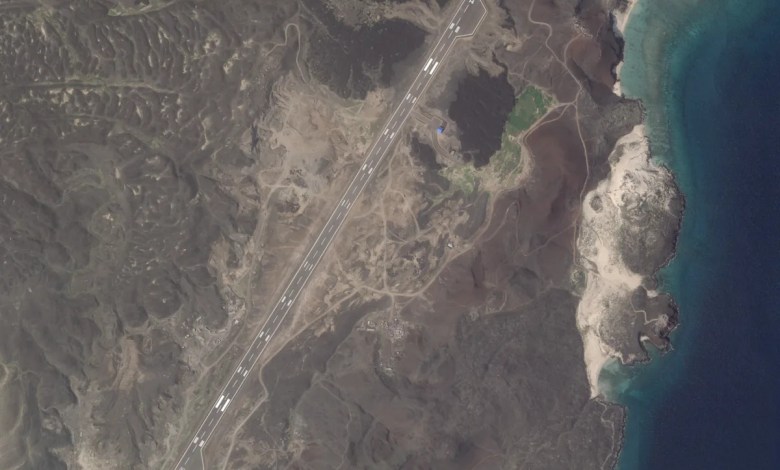As Houthis are increasingly squeezed, a mysterious airport is built on the island of Yemen

DUBAI, United Arab Emirates (AP) — Satellite images show construction of a new airport on a volcanic Red Sea island off the coast of Yemen may be the latest project by forces allied against Iran-backed Houthi rebels.
Zukar Island’s airstrip provides another link to the region’s network of maritime bases, a key area for international shipping. During Israel’s war with Hamas, the Houthis have attacked more than 100 ships in the area, sinking four vessels and killing at least nine sailors.
It could give the military the ability to conduct aerial surveillance of the Red Sea, the Gulf of Aden and the strategically narrow Bab el-Mandeb Strait, two waterways connecting East Africa and the Arabian Peninsula.
Still, it’s unclear what would trigger the airport to be used for military operations. The United Arab Emirates, which has built other runways in the region, did not respond to a request for comment. Nor have Yemen’s anti-Houthi forces, divided by warring interests, unable to mount a coordinated attack on the rebels even after heavy U.S. and Israeli bombing campaigns targeting the rebels.
Anti-Houthi forces have been able to intercept more shipments destined for the Houthis in recent months, and a presence in Zuqar could help.
Eleonora Aldemani, an analyst at the Italian Institute of International Politics who has long studied Yemen, said: “The possibility of a new offensive in Yemen with the support of the Saudi-led coalition against the Houthis cannot be ruled out, although I do not think this situation has come yet.”
“I think there’s a more important point about Zukar’s build-up: combating Houthi smuggling, especially weapons smuggling,” she said.
Runway on strategic island
Planet Labs PBC satellite photos analyzed by The Associated Press show a nearly 2,000-meter (6,560-foot) runway under construction on Zuqar Island, about 90 kilometers (55 miles) southeast of the Houthi-controlled port city of Hodeidah, a key shipping hub.
Pictures show pier construction on the island starting in April, followed by land clearing along the runway. In late August, the runway appeared to be paved with asphalt. Images from October show work continuing, with runway markings drawn mid-month.
No one claimed the building. However, ship tracking data analyzed by The Associated Press showed that the Batsa, a Togo-flagged bulk carrier registered to a Dubai-based maritime company, sailed from Berbera, Somaliland, home to the DP World port, and spent nearly a week at a new terminal on Zukar Island. DP World declined to comment.
Dubai-based shipping company Saif Shipping and Marine Services acknowledged receiving an order to deliver bitumen to the island on behalf of other Emirati companies for potential airport construction. Other UAE-based maritime companies have also been linked to other airport construction projects in Yemen and later the UAE.
The UAE is believed to have supported several runway projects in Yemen in recent years. In Mocha on the Red Sea coast, an expansion project at the city’s airport can now land larger planes. Local officials credited the project to the United Arab Emirates, a federation of seven emirates that includes Abu Dhabi and Dubai. There is now also a track at nearby Dhubab.
The other runway is located on Abdul Khouri Island in the Indian Ocean near the mouth of the Gulf of Aden. In the Bab el-Mandeb Strait itself, another UAE-built runway is located on Mayun Island. Yemen’s anti-Houthi separatist Southern Transitional Council, long backed by the UAE, controls the island and recognizes the UAE’s role in building the airport.
Goods targeting the Houthis
Zukar Island is a strategic location in the Red Sea. Eritrea occupied the island in 1995 after fighting with Yemeni forces. In 1998, the International Court of Justice formally placed the island under Yemeni jurisdiction.
In 2014, the Houthis captured the Yemeni capital Sanaa and began to march south. Later, the rebels occupied Zukar and the island fell into war again.
In 2015, Saudi Arabia and the United Arab Emirates entered the war on behalf of the country’s exiled government, halting the Houthis’ advance. They also pushed back the Houthis from Zuqar and recaptured the island, which has become a staging ground for naval forces loyal to Tariq Saleh, the nephew of Yemen’s late strongman leader Ali Abdullah Saleh.
The young Saleh, who had been allied with the Houthis until his uncle defected and was killed by the rebels, was backed by the United Arab Emirates.
Since then, the war front has remained dormant for years.
What has changed is that the Houthis have expanded their operations globally, attacking ships in the Red Sea and the Gulf of Aden. This continued even after weeks of intense U.S. airstrikes known as Operation Rough Rider and continued Israeli strikes. Despite the rebels’ preference for secrecy, Israel appears to be closing in on the Houthis’ top leadership.
“The Houthis, like any rebel group, cannot win unless they lose,” Yemen expert Gregory D. Johnsen wrote in June. “This is how the group survives and thrives in every war.”
While a loose anti-Houthi coalition exists, it remains fragmented and has not launched any attacks amid U.S. airstrikes. But a growing network of air bases around Yemen has come as anti-Houthi rebels have made multiple seizures of large quantities of weapons that were likely destined for the rebels, including a large haul praised by U.S. Central Command.
“There could be an Emirati airstrip in Zouqar that could improve surveillance and monitoring of the Hodeidah coast and better support the Yemeni army in its fight against smuggling,” Admani said.



